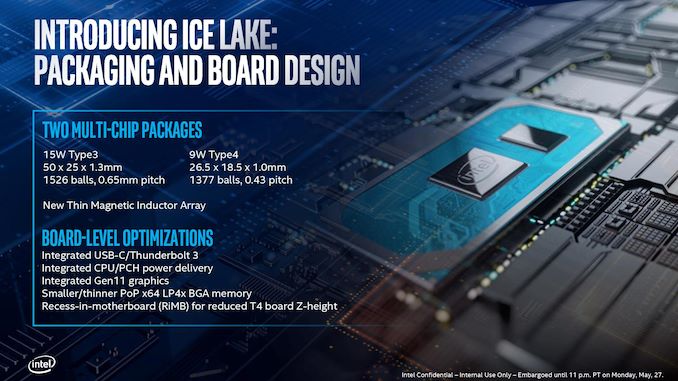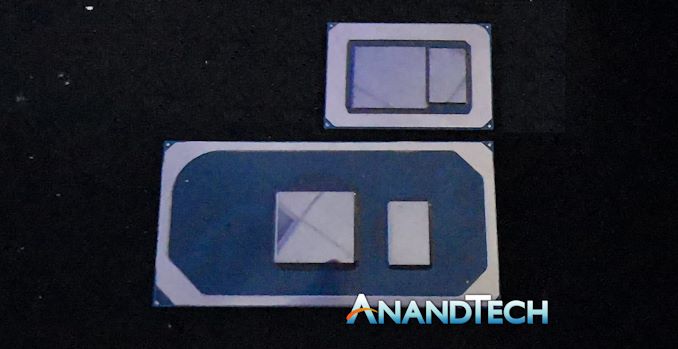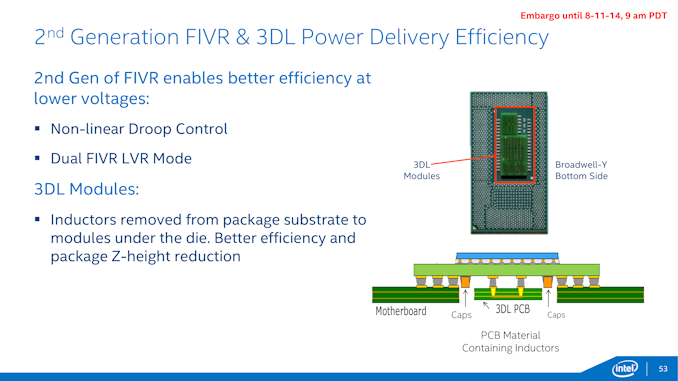Examining Intel's Ice Lake Processors: Taking a Bite of the Sunny Cove Microarchitecture
by Dr. Ian Cutress on July 30, 2019 9:30 AM EST- Posted in
- CPUs
- Intel
- 10nm
- Microarchitecture
- Ice Lake
- Project Athena
- Sunny Cove
- Gen11
Two Versions, Two Different Power Targets
Intel has promised that Ice Lake-U will be seen in a variety of form factors, targeting anywhere from 9W to 28W. This sort of range is not new for a U-series processor – we typically see overlap from something lower down (the Y-series, ~5W) or higher up (H-series, ~45W), however Ice Lake hasn’t currently been listed for H series power budgets - only Y and U. Having such a wide window, from 5-28W, allows Intel to be very wide with binning the chips as they come of the production line, which is a very valid tactic for promoting as much yield as possible with minimal waste.
Technically there will be two different Ice Lake BGA mobile packages – one aimed at low power (7-12W) for the Y series, and another for higher power designs (15-28W) in the U series.
At this point Intel has not stated what core configurations will be in both packages, however it is likely that the lower power 7-12W ‘Type 4’ package will be for Y-series implementations only, especially given that the overall package size is only 490mm2 (26.5x18.5) compared to 1250 mm2 (50x25), making it 39% the size of the larger high power package. It stands to reason then that the smaller package is for lower performance and low power options, despite being exactly the same silicon.
This Type-4 option also uses the ‘recessed in board’ design we first saw with Broadwell-Y, which is required based on the integrated voltage regulators that Intel now uses on its low powered designs. This makes a very interesting point about Intel’s capabilities with low powered 10nm designs: one could postulate that as the recessed model is well above the traditional Y-series power line. If the 10nm process doesn’t go low down enough in power to that sub-5W range, it could either be because of power, or there isn't enough frequency for Intel to actually sell at volume. Alternatively Intel could end up increasing the base power of the Y-series. One could draw parallels with the first generation 10nm Cannon Lake Core i3-8121U at 15W, which was initially postulated to be dual-core Y-series silicon, rather than the 15W U-series designation it ended up with (our review showed that it did indeed consume more power for the same work compared to a 14nm equivalent design, which would imply a very high static power). With this in mind, it makes me wonder what percentage of Type 3 / Type 4 package designs Intel will end up shipping into the market.
Broadwell Motherboard Design for Recessed Power Implementation
Intel is keen to promote that one of the new features of Ice Lake is its Thin Magnetic Inductor Array, which helps the FIVR achieve better power conversion efficiencies and waste less power. The main issue with a FIVR is at low power consumption states that have a lot of inefficiency – some other processor designs have a linear LDO (Low-Dropout Regulator) implementation which is better for low power designs but less efficient in high power modes.













107 Comments
View All Comments
The_Assimilator - Wednesday, July 31, 2019 - link
Getting Thunderbolt on-die is huge for adoption. While I doubt many laptop manufacturers will enable more than a single TB port, desktop is an entirely different kettle of fish.umano - Wednesday, July 31, 2019 - link
I am afraid but I cannot consider 4 cores cpu as premiumKhenglish - Wednesday, July 31, 2019 - link
This honestly is looking like the worst architecture refresh since Prescott. IPC increases are getting almost completely washed out by loss in frequency. I wonder if this would have happened if Ice Lake came out on 14nm. Is the clock loss from uArch changes, process change, or a mix of both?Performance of an individual transistor has been decreasing since 45nm, but overall circuit performance kept improving due to interconnect capacitance decreasing at a faster rate at every node change. It looks like at Intel 10nm, and TSMC 7nm that this is no longer true, with transistor performance dropping off a cliff faster than interconnect capacitance reduction. 5nm and 3nm should be possible, but will anyone want to use them?
Sivar - Wednesday, July 31, 2019 - link
"...with a turbo frequency up to 4.1 GHz"This is the highest number I have come across for the new 10th generation processors, and according to SemiAccurate (which is accurate more often than not), this is likely not an error.
If this value is close to desktop CPU limitations, the low clock speed all but erases the 18% IPC advantage -- an estimate likely based on a first-gen Skylake.
Granted, the wattage values are low, so higher-wattage units should run at least a bit faster.
Farfolomew - Wednesday, July 31, 2019 - link
I’m a bit confused by the naming scheme. Ian, you say: “The only way to distinguish between the two is that Ice Lake has a G in the SKU and Comet Lake has a U”But that’s not what’s posted in several places throughout the article. The ICL processors are named Core iX-nnnnGn where CML are Core iX-nnnnnU. Comet lake is using 5 digits and Ice Lake only 4 (1000 vs 10000 series).
Is this a typo or will ICL be 1000-series Core chips?
name99 - Wednesday, July 31, 2019 - link
Regarding AI on the desktop. The place where desktop AI will shine is NLP. NLP has lagged behind vision for a while, but has acquired new potency with The Transformer. It will take time for this to be productized, but we should ultimately see vastly superior translation (text and speech), spelling and grammar correction, decent sentiment analysis while typing, even better search.Of course this requires productization. Google’s agenda is to do this in the cloud. MS’ agenda I have no idea (they still have sub-optimal desktop search). So probably Apple will be first to turn this into mainstream products.
Relevant to this article is that I don’t know the extent to which instructions and micro-architectures optimized for CNNs are still great for The Transformer (and the even newer and rather superior Transformer-XL published just a few months ago). This may all be a long time happening on the desktop if INTC optimized too much purely for vision, and it takes another of their 7 years to turnaround and update direction...
croc - Thursday, August 1, 2019 - link
It seems that Ice Lake / Sunny Cove will have hardware fixes for Spectre and Meltdown. I would like to see some more information on this, such as how much speed gain, whether the patch is predictive (so as to block ALL such OOE / BP exploits) etc.MDD1963 - Thursday, August 1, 2019 - link
A month or so ago, we heard a few rumors that the CPUs were ahead ~18% in IPC (I see that number again in this article), but are down ~20+% in clock speed.... ; it would be nice to see at least one or two performance metrics/comparisons on a shipped product. :)isthisavailable - Thursday, August 1, 2019 - link
Unlike Ryzen mobile, intel’s “upto” 64 EUs part will probably only ship in like 2 laptops. Therefore amd has more designs in my book. I don’t understand people who buy expensive 4K laptops with intel integrated gfx which can’t even render windows 10 ui smoothly.Looking forward to Zen2 + navi based 7nm APU.
Bulat Ziganshin - Thursday, August 1, 2019 - link
> it can be very effective: a dual core system with AVX-512 outscored a 16-core system running AVX2 (AVX-256).it's obviously wrong - since ice lake has only one avx-512 block but two avx2 blocks, it's not much faster in avx-512 mode compared to avx2 mode
the only mention of HEDT cpus at the page linked is "At a score of 4519, it beats a full 18-core Core i9-7980XE processor running in non-AVX mode". Since AVX-512 can process 16 32-bit numbers in a single operation, no wonder that a single avx-512 core matches 16 scalar cores